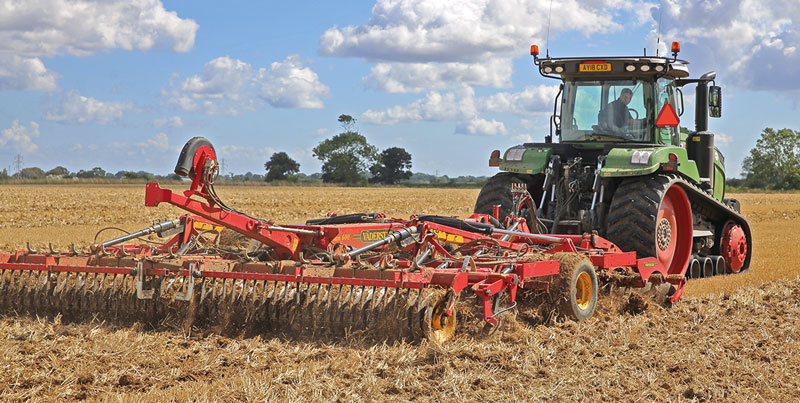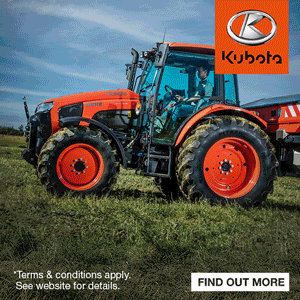Latest Fendt crawler impresses on Suffolk farm
24th July 2019
Fendt designed and branded rubber-track crawlers were announced last year, some with new technology borrowed from the German manufacturer’s largest wheeled tractors. David Williams has been finding out how they

Fendt designed and branded rubber-track crawlers were announced last year, some with new technology borrowed from the German manufacturer’s largest wheeled tractors. David Williams has been finding out how they perform.
Fendt designed and branded rubber-track crawlers were announced last year, some with new technology borrowed from the German manufacturer’s largest wheeled tractors. David Williams has been finding out how they perform.
The Fendt crawler line-up includes 7 models in 2 sizes, from 380–646hp. Both result from Challenger’s incorporation within the Fendt brand but, whereas the new 1100MT models are mechanically similar to the previous MT800-series, the smaller MT700-series has been replaced by all-new 900 Vario MT models.
Externally the most noticeable change, apart from green paintwork, is a Fendt cab but under the body panels is a Fendt Vario CVT transmission, track and cab suspension and Fendt controls.
With fewer changes the 1100MT models have been available since early this year but the 900 Vario MT models have only recently arrived on farms.
Farmers Guide visited a north Suffolk farm which was one of the first to take delivery of one of the new models.
Mark Hadingham and his son Ben farm in north-east Suffolk and just over the Norfolk border, trading as Retreat Farms and Flixton Farms Ltd. Approximately 1,600ha is farmed across 4 sites and the land is a mix of owned and contract-farmed. Most soil is Beccles-series clay but there is also some lighter land at Blyford nearer the coast.
“Our soil is a delicate asset,” commented Mark. “We have to look after it carefully so we moved to tracks approximately 20 years ago. We have a policy of not carrying out cultivations with wheeled machines and our wheeled tractors are used mainly for tasks including transport and hedge cutting. Since moving to tracks our soil structure has benefitted and although tyre technology has improved considerably in recent years, we don’t feel they provide the same soil protection. And it’s not only the soil that gains an advantage; tracks allow us to work more efficiently and get more from our machines.”
The first rubber-tracked crawler purchased was a Caterpillar, later replaced by a Claas-branded version. Then another brand was operated briefly before settling on Challengers, supplied through East Anglian main dealer Thurlow Nunn Standen.
In recent years the fleet has included two 765s and a larger 865. A 765D was recently part-exchanged for a new Fendt crawler which arrived in early August, and which complements the farm’s 765C and a larger 865C.
Cropping includes winter oilseed rape, sugar beet, vining peas, winter barley, spring barley and some rye and crops are established using Vaderstad 6 and 8m Rapid drills.
Cultivations are mainly min-till although ploughing is carried out where needed. The plough is a Gregoire Besson 9f reversible and cultivators include a 6m Vaderstad Top Down, a 6m Vaderstad Rexius Press, an 8m Vaderstad NZ seedbed cultivator and a 6m RapidLift toolbar mounted to the farm’s 6m Vaderstad Rapid drill. Mole ploughing and subsoiling are carried out where needed.
“During the autumn we often have all three crawlers working, but only bought the 800-series crawler because the smaller 700-series wasn’t available with the same power,” explained Mark. “We didn’t want to go to the bigger model to do more work, but needed pulling capacity for the plough and drilling with the RapidLift toolbar fitted.”

Main user Jordan Burcham said the new models offer 100 per cent improvement for operators and that it will be hard to spend a day on the farm’s Challengers after a week on the Fendt.
Easy decision
When Mark heard of the new Fendt models he was optimistic that pulling capacity would be increased and attended a demonstration in Lincolnshire earlier this year. “It was good to see the Challenger replaced, but improved and brought up to the next level,” he said. “We have considered other brands and keep an eye on alternatives but believe the new Fendt models offer the best design and performance.”
The farm ordered a new 943 Vario MT, the flagship of the 900-series with 431hp. Mark believes the new tractor’s additional power will allow it to share larger implements with the 800-series, making field operations more efficient.
By the time of Farmers Guide’s visit the new tractor had worked 110 hours, and field work had included mole draining and cultivating with the 6m TopDown.
“It’s improved 100 per cent over the previous 765D,” commented main operator Jordan Burcham. “It’s hard to compare as it is so different but I know that using the older models again will come hard. The transmission is obviously very different as the CVT and engine adjust continuously for optimum performance. Previously I was always changing powershift gears and a low ratio had to be selected for pulling away otherwise it could stall. Then moving up through the gears took a while until the operating speed was reached.”
The new Fendt Vario crawlers have a similar transmission to 1000-series wheeled tractors. Twin hydraulic motors control the power split between hydraulic and mechanical giving variable speed control with a bias to mechanical transmission for high torque at low speeds and hydraulic at higher speeds, saving fuel. The operator can select manual mode; adjusting the engine and transmission independently or select ‘TMS’ by pressing a button on the control panel, allowing engine and transmission management by the tractor’s systems for lowest engine revs and maximum fuel economy.
Response to varying loads is adjustable. A constant engine speed can be maintained regardless of load, or allowed to reduce within pre-set limits, saving fuel.
Travel speed control is by the Vario multi-function joystick, but the operator can also select control through the foot drive pedal. “The foot pedal has advantages on the road,” explained Jordan. “On narrow lanes I can slow down while passing cars, then just depress the foot pedal again to pull away. Everything adjusts automatically leaving me free to watch the road whereas the previous Challenger with powershift needed me to concentrate on shifting from the lowest gears all the way up the range, and avoid stalling.”
Speed control sensitivity is adjustable in four stages, using a small selector on the joystick. For rapid reaction to joystick commands the selector is set to most aggressive and for more relaxed operation and a smoother ride, response is reduced.
Superb ride quality
The new Fendt tractors have an all-new track and carriage design, including suspension. ConstantGrip comprises a double pendulum within each track assembly allowing the tracks to mould around undulations, maintaining even ground pressure along their length and across the track width.
Large coil springs and shock absorbers support the chassis and provide up to 23cm vertical movement for each track, with up to 11 degrees swing angle also available, while a torque rod stabiliser ensures lateral stability.
The cab is suspended as is the seat and Fendt claims comfort and noise levels equivalent to a premium wheeled tractor.
“Ride quality is great on the road and in the field,” confirmed Jordan. “When the tractor first arrived the ground was rock hard after the long summer drought but track vibration was hardly noticeable. The improved ride means I can make the most of the power to achieve higher working speeds than before, so the tractor is more productive.”
The cab is almost identical to that of the 1000 Vario tractors including a 10.4in Varioterminal touch-screen to set up and monitor operating parameters. “It’s clear and easy to see, even in bright sunlight,” commented Jordan, “and the menus are logical so it doesn’t take long to work out how to alter the settings.”
The farm has its own RTK network and the tractors use Topcon GPS field mapping. Variotronic Turn Assistant on the new Fendt can be used to negotiate headland turns automatically, and was proving popular with Jordan.
Visibility all around was described as excellent, including to the implement at the rear and Jordan said he especially likes the mirrors, which provide excellent side and rear views on the road and of the implement in the field. Some late evening work has been carried out and the working lights are impressive.
Fuel and time savings
Mark said that although it is hard to accurately compare fuel consumption between tractors, he believes the Fendt crawler uses significantly less than the Challengers, and explained this is partly due to the low revving engine and TMS mode which makes the most of the engine’s performance. Pulling the 6m TopDown at 6–7in depth on heavy soils at 10kph, the engine was running at just 1,300, whereas Mark commented that the Challenger 765D probably couldn’t have pulled it at similar speeds, but typically required 2,100rpm in less demanding situations.
Adblue use also appears lower, added Mark, but he said both tractors require a top-up each time the diesel tank is filled. Daily checks are improved and Jordan explained that hydraulic and transmission oil levels are checked in seconds using sight gauges at the rear, and the engine oil dipstick is easy to get at without removing any covers. The cooling system is similar to the Fendt 1000-series wheeled tractors with a concentric hydraulic-driven fan pushing cool air through from the front. So far this has remained clean, even in dry, dusty working conditions.
Part of the track system’s redesign includes plastic wear discs at the rear of the centre rollers. Thurlow Nunn Standen’s Challenger and Fendt specialist Dave Lovell explained that side thrust during work forces the rubber drive lugs against the backs of the rollers and on the Challenger they could overheat, damaging the outer rubber band and causing premature failure. The new plastic wear discs help prevent heat build-up and should significantly extend working life.
Extra flexibility
The 6m TopDown on the heavy soils was a good match for the new crawler and during Farmers Guide’s visit, the cultivation depth was set to maximum to see how it affected performance. At 10in on the headlands the Fendt coped easily at 8–10kph, and its capability impressed Mark. “It didn’t struggle and the tractor continues to surprise me. We tend to be restricted during drilling using the more powerful 800-series Challenger, as we have to start in a low gear and change up again through the powershift steps after every headland turn.
“We could drill faster, but above 12kph there is a big step to the next gear as the clutch packs swap over which affects drilling performance, so that has become our maximum. However, I think the new Fendt Vario model with its CVT transmission will provide much greater flexibility and from what I have seen so far it has the power and traction to handle the drill. I think we will achieve higher work rates than were possible previously, while saving fuel and without increasing tractor size and weight.”
Investment stacks up
The Fendt was purchased with an 8-year, 8,000-hour warranty. “Previously we updated Challengers every 3 years or 3,000 hours, but with its longer warranty giving additional peace of mind we will probably keep the Fendt longer, which should help reduce ownership costs,” explained Mark.
“I’m convinced the CVT transmission will provide significant advantages for Fendt owners,” said Dave Lovell. “It’s so simple and allows users to get the most from the power available while minimising fuel use.
“Ride quality is excellent and no other tracked machine comes close for comfort. Ownership and running costs should be low and the long warranty provides reassurance. We believe the new models will be popular.”

With the Vaderstad 6m TopDown in at full 10in working depth, the Fendt didn’t struggle.


